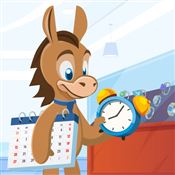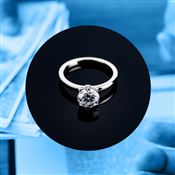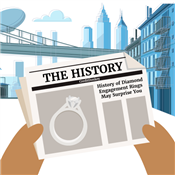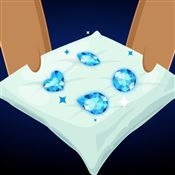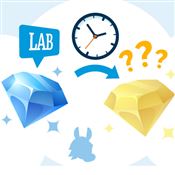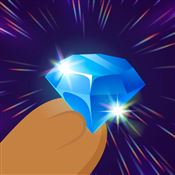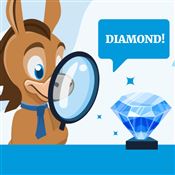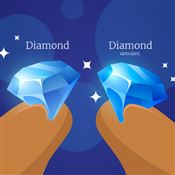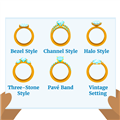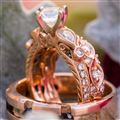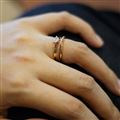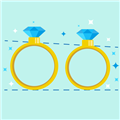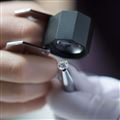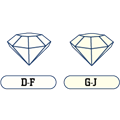How to Buy an Engagement Ring
You hear a diamond is forever when shopping for an engagement ring. But that doesn't mean you need to pay for one that long.
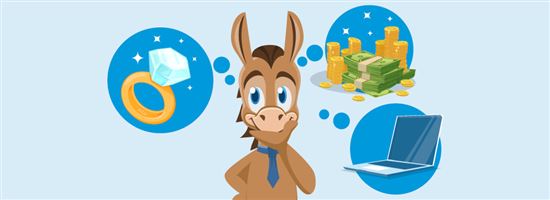 |
Not only are engagement rings expensive, but most ring shoppers also have little to no experience with fine jewelry.
So this process boils down to dropping a few to several thousand dollars on a tiny rock about which you have little knowledge or expertise. It's enough to increase your personal terror alert to red.
Fortunately, she's worth it.
We have the 10 tips you need to help you relax and make a smart engagement ring purchase. Keep reading—you may even save a bit of money along the way.
And after she says yes, you'll wonder why you were ever so afraid of buying an engagement ring.
Bottom Line: We recommend that our readers consider buying their engagement ring online. Online retailers are around 40% cheaper than local jewelers.
Search for Beyond Conflict-Free Diamonds
Shop for diamonds at Brilliant Earth, a CreditDonkey recommended partner for socially-responsible diamonds.
1. Set a Budget
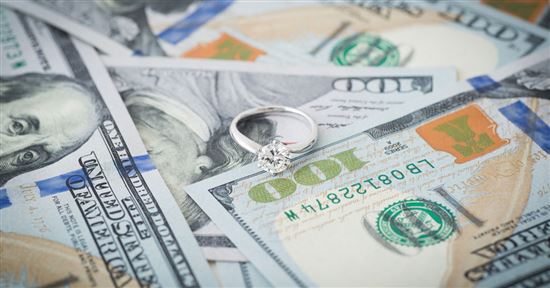 |
Maybe you've purchased a car or a home in your young adult life, so you have some experience with large purchases. Or maybe an engagement ring is your first big ticket item, and you're terrified.
Once you've decided you're ready to be engaged, you must set a budget before you begin shopping. Try to figure out what you can afford without racking up debt.
The average cost of an engagement ring is slightly more than $5,000 but there's no one-size-fits-all rule of thumb. Some people will spend $10,000 on a ring; others will spend $1,000. Just study your finances and pick a number that fits.
Don't let the diamond companies guilt you into a bigger ring than you can afford. Those "suggestions" about spending two or three months (or even more) of salary began as marketing campaigns after World War II that have since worked their way into the public's consciousness.
By sticking to a specific budget, you'll only see rings and stones you can afford at the jeweler. You won't be tempted to purchase a ring out of your price range because you'll never see it.
Here are some things to consider:
- Wedding Plans: When setting the budget, think about what your wedding will cost. If you want to spend more on a wedding down the road, you may need to spend less on the ring now.
- Future Plans: Do you plan to have children or to purchase a house immediately after marriage? These plans require quite a bit of free cash, so you may need to spend less on the ring.
- Financing: You CAN finance an engagement ring. But it's better to buy an affordable one with cash than to be stuck making regular payments (with high interest after the introductory period ends). If you must use financing, we recommend saving as much as you can for three to six months. Then use half cash and half financing for the purchase.
Don't finance any more than the amount you saved in that time period, so you can pay it off in another three to six months. Why blow your finances before you begin your new life by overspending on a ring?
But the interest also won't skyrocket after that introductory period ends, as retail finance plans often do.
Spend only what you can afford now. You can always buy another ring with a bigger diamond for your 10th or 20th wedding anniversary if you choose.
2. Start Saving Now
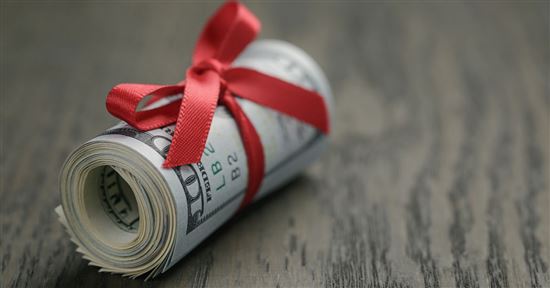 |
Most people will need several months to save the money for the ring, so it's important to plan ahead. Unless you have a lot of cash lying around, you won't be able to decide you're ready to buy a ring on a Friday and have the money on hand by Saturday.
Set a specific plan for how you will reach your savings goal and how long it will take.
Little things will add up over a few months, so think about anything you can do to sock away some money. Sell some things you no longer need. Pick up a temp gig. Eat out less. Then deposit your saved money in a high-yield savings account, such as the Platinum Savings from CIT Bank. It all adds up to help you reach your goal.
As discussed above, try to avoid financing the ring if you can. If you must use financing, use a combination of savings and financing.
3. Avoid Being Ripped Off
 |
We fully acknowledge that it's a lot more fun to spend time planning a perfect way to propose than to spend time studying engagement rings and diamonds. But you need to familiarize yourself with the terminology and choices you'll have before you begin shopping.
One of the most unsettling aspects of buying an engagement ring is a concern over buying a fake ring. Doing some studying ahead of time will help you avoid being ripped off by a seller.
Understand that many jewelers have pre-set rings and diamonds in the display case. But you can also purchase a diamond and a setting separately, having them mounted later. This is a good idea if you want to create something unique.
4. Diamonds: What You Need to Know
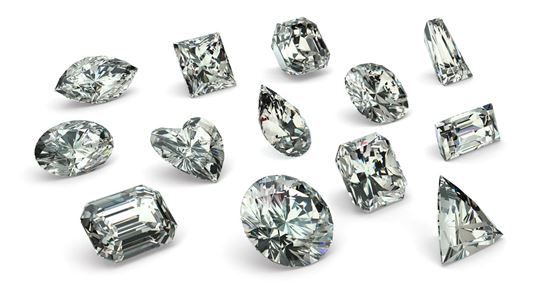 |
When picking a diamond, as long as you know the four Cs, you'll have the basics you need to make a solid decision. A more flawless diamond will rank high on the scale of each of the Cs, but it also will cost more.
We'll explain the basics, and you can then feel free to delve more deeply into any of them to gain a bit more knowledge.
- Carat: Sometimes referred to as weight, this determines the size of the diamond. This is the area where you'll want to allocate a large percentage of your budget.
How many carats is the average engagement ring? In the U.S., the average engagement ring has a diamond of slightly under 1 carat.
Unfortunately, costs go up quickly as the stones increase in size. For example, a 2-carat diamond won't cost double that of a 1-carat diamond; it'll cost more like four times, because larger diamonds are rarer.
- Clarity: Nearly all diamonds have flaws, which often appear as black specks in the stone. Most of these flaws are only visible through a scope. If you cannot see flaws with the naked eye, it's called an eye-clean diamond. Many people really only want a diamond that's close to eye-clean; they don't care about tiny flaws they can't see with the naked eye. If you compromise a bit on clarity, you can spend a bit more on other, more noticeable, aspects of the stone.
Tip: Usually, it's a safe bet that VS2 diamonds will be eye clean. If you're looking at diamonds in person at a store, you can even look for SI1 stones or below.
- Color: Diamonds are given a letter grade to show their color. A clear diamond is the rarest and has the highest grade of D. A yellow diamond will have the lowest grade of Z. If you don't mind a yellowish tint in the diamond, you can save a lot of money. Yellow-ish diamonds are cheaper because they are more plentiful than clearer diamonds.
Tip: If you want a white-looking diamond to be set in a platinum or white gold ring, H color is usually a good choice for value.
- Cut: For many people, paying attention to cut is the most important aspect. The cut determines how much sparkle the diamond has, which can make the stone look bigger than it is. Cut has a big impact on the beauty of the diamond, so don't try to save here. Save on the other aspects instead.
- Shape: Many people confuse cut with shape. The shape means the appearance of the diamond - round, oval, emerald, etc. The shape also affects what kind of mount you can use on the ring. Certain ring styles won't look right with certain shapes of stones. Round stones are the most common (found in about 75% of engagement rings), but some people prefer an oval or teardrop (pear) shape to stand out from the crowd. Princess and cushion cuts are square-ish but are considered to be feminine.
Related: Crash Course in Diamond Prices: Finding Best Value
5. Engagement Rings: What You Need to Know
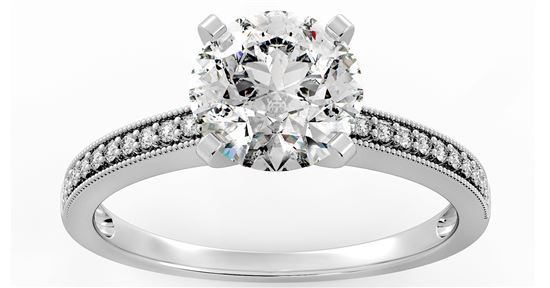 |
For the ring itself, you'll pick the metal of the ring, as well as the style of the setting.
In terms of style, engagement rings are usually more ornate and feature a diamond (or other gems). Wedding bands tend to be simple bands of precious metals like platinum or gold.
- Platinum: A platinum ring carries a silver-ish color and is a long-lasting metal. However, it doesn't hold its luster as well as a gold ring.
- Gold: A gold ring provides a traditional look, but it's not as strong as platinum. It costs less than platinum too. Different variations of gold are available, including rose gold, white gold, and yellow gold (read about the differences).
Related: 10k, 14, or 18k Gold: Which Is Best for Engagement Ring
Some people will choose to use a gold ring with platinum prongs, which will hold the diamond in place stronger than a gold setting. If the gold prongs wear out over time, the diamond could fall out.
Additionally, the type of setting you pick can change the look of the diamond, making it appear larger. For example, a halo setting makes the diamond look huge.
The setting can be a great way to personalize the ring, which is why some men choose to let their fiancée pick her own setting. Some jewelers will allow you to buy a diamond and place it in a temporary setting for the proposal. You then can go back together later and pick a different setting if desired.
6. Jewelers: What You Need to Know
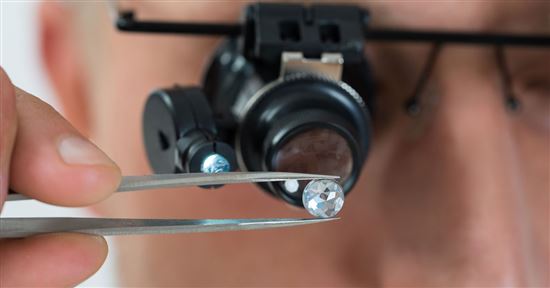 |
Finding trustworthy jewelers just requires checking their validity through a couple of certification organizations.
The American Gemological Society (AGS) and the Gemological Institute of America (GIA) perform certification efforts that ensure the validity and grading of the diamonds jewelers are selling.
The jeweler should provide certifications for your stone before you purchase it, and you can verify these before handing over your money. You will then have some peace of mind about what you're buying.
Additionally, ask about any contracts you must sign. Will you have any opportunity to exchange or resize the ring after you buy it? Is there a return period with full cash back or store credit? Tell the jeweler when you plan to propose and ask if you can return the ring for changes after that date. Be extremely careful about signing a contract without fully understanding what you're signing.
Visit multiple jewelers in person and online before picking one, asking about certifications provided and contracts. Check customer reviews of the jewelers.
Finally, understand that you will be dealing with a salesperson during this process. The salesperson knows more about jewelry and diamonds than you do, so you should rely on his or her advice. But this salesperson is also trying to convince you to spend as much as possible, which will result in a larger sales commission, so be on your guard.
If the salesperson immediately starts showing you rings and diamonds that are beyond your stated budget, this is a very bad sign. Leave and try another jeweler.
And don't feel guilty about asking for a lower price, just as you would with a car. Most people don't haggle on prices for diamonds, but it never hurts to try. Don't be afraid to walk out the door if you're unhappy with any part of the sales process. It may help you to think of this transaction like buying a car, and you can use some of the same techniques you'd use with a car salesperson.
Ask the salesperson if they're willing to match the price of stones or rings you find elsewhere. Many will say no because every stone and every ring is a little different. But if you find someone who's willing to haggle, you may save a bit of money.
The most popular site is Blue Nile. I've found James Allen to be slightly cheaper.
Online shops charge far lower prices because they don't have the overhead. In addition, given these sites are online, their inventory is greater. They are not bound by physical "shelf space" or displays. As a result, consumers have options... and with greater options come lower prices. A sales rep at a physical jewelry store will only give you a handful of choices - none of which may be in reasonable or comparable price ranges.
7. Shopping Online: What You Need to Know
 |
Some people choose a diamond online and then have it shipped to a local jeweler for the final mounting work. Others allow you to design a ring online and have it shipped directly to you for mounting with a diamond you already own. Or you can purchase the finished ring and stone together online.
Before purchasing any diamond or ring online, be sure to request documentation on the diamond that you'll be receiving. Then double-check the documentation.
Ultimately, picking a jeweler is a personal choice. You may find that an online jeweler is better for you, or you may feel like this is a purchase you need to make face to face.
But before going to a local jeweler, consider reputable online retailers. These stores offer high-quality images and videos of their gems so shoppers know what they're getting.
Related: Best Places to Buy an Engagement Ring Online
8. Figuring Out Her Ring Size
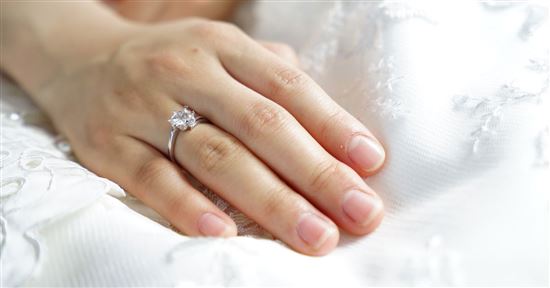 |
Certainly, buying the wrong size of ring is usually easy to fix later, after you propose. But there's just something about a surprise proposal where the ring fits perfectly that makes it memorable... versus the awkward screaming when the ring scrapes off her skin as you try to squeeze it onto her finger.
Although you don't want to have secrets and be sneaky around your fiancée after you're married, she'll forgive you here. Try to "borrow" one of the current rings that she wears on her ring finger to take to the jeweler to figure out her exact ring size. (Don't pick a ring she normally wears on her thumb, or you're going to be way off on size.)
Or trace the inside and outside of a current ring for her ring finger on a piece of paper and take that to a jeweler. If she often shares jewelry or gloves with a sister or best friend because they have almost the same ring or hand size, ask the friend for her ring size.
If she doesn't wear any rings, you can stealthily measure her finger while she sleeps. When she's sleeping, wrap a string (or strip of paper) around her left ring finger. Then take it to a jeweler or get the size with our ring size chart.
If nothing else, the most common ring size for a woman is 6. So you can make a guess from there, keeping in mind that buying a ring that's a little too big is better than one that's a little too small. Just be sure to ask the jeweler about ring resizing options down the road.
Related: Everything You Need to Know About Ring Resizing
9. Picking the Right Ring
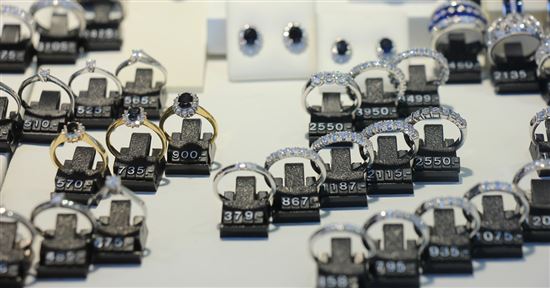 |
OK, now it's time for the serious decision: picking the ring style. This is the toughest part for most guys.
For someone with little to no experience with jewelry, you have to pay attention and take some hints from her to pick a great ring style.
- Current Jewelry: Look at what she likes to wear now and try to mimic that with your selection of a ring. Does she like gold over platinum/silver? Does she like simple jewelry? Is bigger better in her mind? Or is she OK with subtle?
If you can secretly take pictures of rings she currently wears, a jeweler can help you match her current tastes too.
- Consider her personality: The style of the ring should match her personality and fashion tastes. If she's usually understated, she may not want something too gaudy. Here are some suggestions:
- Simple and traditional: solitaire - less is more!
- Elegant and trendy: pave or channel
- Glamorous and bold: halo
- Romantic and nostalgic: vintage-inspired
- Outdoorsy and active: bezel
- Quirky: colored non-diamond stone
- Modernist and artsy: tension
- Simple and traditional: solitaire - less is more!
- Check Social Media: If your girlfriend has a Pinterest or other type of social media page where she puts her ideas regarding her dream wedding, perhaps she has posted some ideas about engagement rings.
- Ask Her Friends: She may have described her dream engagement ring to friends, sisters, or mom. So ask them... after swearing them to secrecy first, of course. If you really can trust them to maintain silence, consider taking them along to the jeweler for some hands-on help.
- Unconventional: Some women (roughly 10%) prefer a different stone than a diamond in an engagement ring. Sapphires are a common choice for a non-diamond wedding ring, and they appear in many colors, which can be fun and unique. They're also cheaper than diamonds, which means you can afford a larger stone.
10. Take Her Along
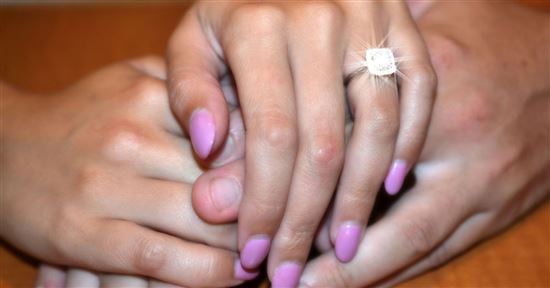 |
If you're still nervous about picking the right style of ring, there's one other option: take her along and let her pick her own ring. (Full disclosure: I did this, and I'm still married, so it can work.)
Of course, this ruins any surprise element you may have for proposing with the ring in hand. But if you put a little extra thought into the planning process, you can still surprise her with a proposal - minus the ring - before you go to the jewelry store.
We suggest scoping out a few jewelers on your own first. Look for a trustworthy salesperson that you know your girlfriend - now fiancée - will love.
Make sure that salesperson knows your budget ahead of time, so you don't have to have a conversation about money once your fiancée arrives. This way, the salesperson doesn't show her rings outside your budget.
However, understand that some slimy salespeople will choose to ignore your stated budget once you bring your fiancée with you, hoping she'll fall in love with a more expensive ring and you'll spend more money, resulting in a bigger commission. This is horrible, but it does happen sometimes.
Once you take your fiancée along, you will lose some control of the situation and could end up spending more than you planned, so think carefully before doing this. You're also canceling your best chance to show how romantic you can be with a surprise proposal, ring in hand.
If you're concerned about her liking the ring you'll pick, understand that for many women, the excitement and surprise of the proposal make almost any ring look perfect... as long as you're the one offering it.
Write to Kyle Schurman at feedback@creditdonkey.com. Follow us on Twitter and Facebook for our latest posts.
Note: This website is made possible through financial relationships with some of the products and services mentioned on this site. We may receive compensation if you shop through links in our content. You do not have to use our links, but you help support CreditDonkey if you do.
|
|
| ||||||
|
|
|









